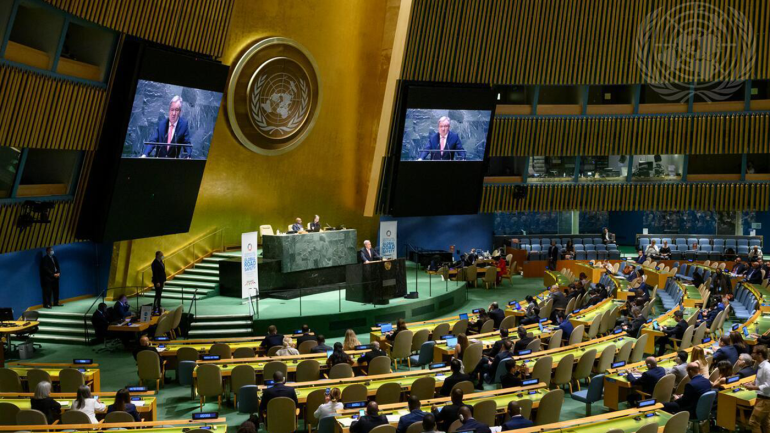
UNITED NATIONS -- The world is a troubled place these days as leaders cope with war, nuclear weapons, inflation and food shortages, but the General Assembly of the United Nations this week stayed laser-focused on an issue close to almost everyone's heart: How to reduce deaths on the road.
Jean Todt, U.N. Special Envoy for Road Safety, devoted his life to racing as a former CEO of Ferrari, former president of the International Automobile Federation (FIA) and founder of a Paris hospital for brain and spinal injury -- before being appointed to his post at the U.N.
"I wanted to give something back to the society in a surrounding I had some experience," he told CBS Sports.
His goal: Halve the number of deaths from road crashes by 2030.
'It's a pandemic'
"Our solutions are simple, like reducing speed, wearing your helmet or your seatbelt. … Others are more complicated," Todt said, making the point that 90% of road accidents occur in developing countries.
"For example, building busier roadways away from schools dramatically lowers fatalities, but for a solution like this, we need to be involved early in the city- and route-planning stages to be effective," he added.
"It is a pandemic that has not been addressed as it should be."
The former race car driver and Ferrari CEO said history shows that, with enough focus, the world can decrease deaths on the road.
"History has proven that, if the world works together this way, we can achieve the seemingly impossible. Only a century ago, average global life expectancy at birth was about 32 years old. Today, mostly due to medical science, it is 73 years," Todt said.
"We are aiming for 50% fewer deaths on the road by 2030 and have much less time to achieve this, but we already have many of the solutions. By working together to apply a system approach in all mode of transport, we can achieve these goals."
The U.N.'s high-level two-day meeting on "Global Road Safety" adopted a declaration on Thursday. It was led by Todt as well as U.N. Secretary General Antonio Guterres, President of the General Assembly Abdulla Shahid and Stewart Simonson, assistant Director-General of the World Health Organization.
Flowers were displayed in the lobby of the iconic General Assembly hall to commemorate victims of road crashes.
"Traffic accidents can push entire families into poverty through either the loss of a breadwinner or the costs associated with lost income and prolonged medical care," said Guterres.
Shaheed said this is the first time that the important issue of road safety is being discussed at a high-level meeting of the General Assembly.
It's only gotten worse: Action plan adopted
Around the world and in the United States, the facts are grim.
- Road traffic injuries are the leading cause of death for children and young adults aged 5-29 years
- Road crashes claim 1.3 million lives, injuring 50 million a year
Nations at the meeting adopted a new plan that adds to the ones Todt had established when he took the job, including to build better infrastructure on roads, lower speed limits, require safety measures in new cars and raise money. Todt already has secured some funds from the U.N. and World Bank, but he says it's not enough.
The new proposal, adopted Thursday, lays out a plan:
- Reduce in road traffic deaths of at least 50% by 2030
- Set national targets to reduce fatalities and serious injuries for all road users with special attention given to the safety needs of those road users who are the most vulnerable to road-related crashes, including pedestrians, cyclists, motorcyclists and users of public transport
- Develop national road safety targets with the World Health Organization to track progress
- Implement a 'Safe System' approach through policies that foster safe urban and rural road infrastructure design and engineering; set safe adequate speed limits supported by appropriate speed management measures; establish, where possible, an optimal mix of motorized and non-motorized transport, with particular emphasis on public transport, walking and cycling, including bike-sharing services, safe pedestrian infrastructure and level crossings, especially in urban areas
- Increase international financing & technical assistance for highway construction, emissions, and for sharing data
A U.S. scourge as well
As summer begins -- with July 4 travel ahead -- more Americans are hitting the road, which leads to more accidents teenagers being put at higher risks.
AAA predicts roughly 42 million Americans will take a road trip by car of 50 miles or more.
The Centers for Disease Control says 16- to 19-year-olds are three times more likely to be involved in a fatal accident compared to older drivers.
"Road traffic deaths in the U.S. hit a 16-year high in 2021, jumping 10% from 2020," CBS News transportation correspondent Errol Barnett told CBS Sports.
"Now, as summer travel continues and flight cancellations become more common, we're encountering people opting to drive on really long road trips rather than take a risk with an airline. This means we could see even bigger fatality numbers this year, if those increased driver trends continue," Barnett said.
As a former professional driver, Todt says that half of all road traffic deaths are among vulnerable road users such as pedestrians, cyclists and motorcyclists.
"What is certain is that we all know of someone who lost their life in a road crash," he said, adding that the global focus can make road crashes to not be an "invisible" problem.
Pamela Falk is CBS News correspondent based at the United Nations




















